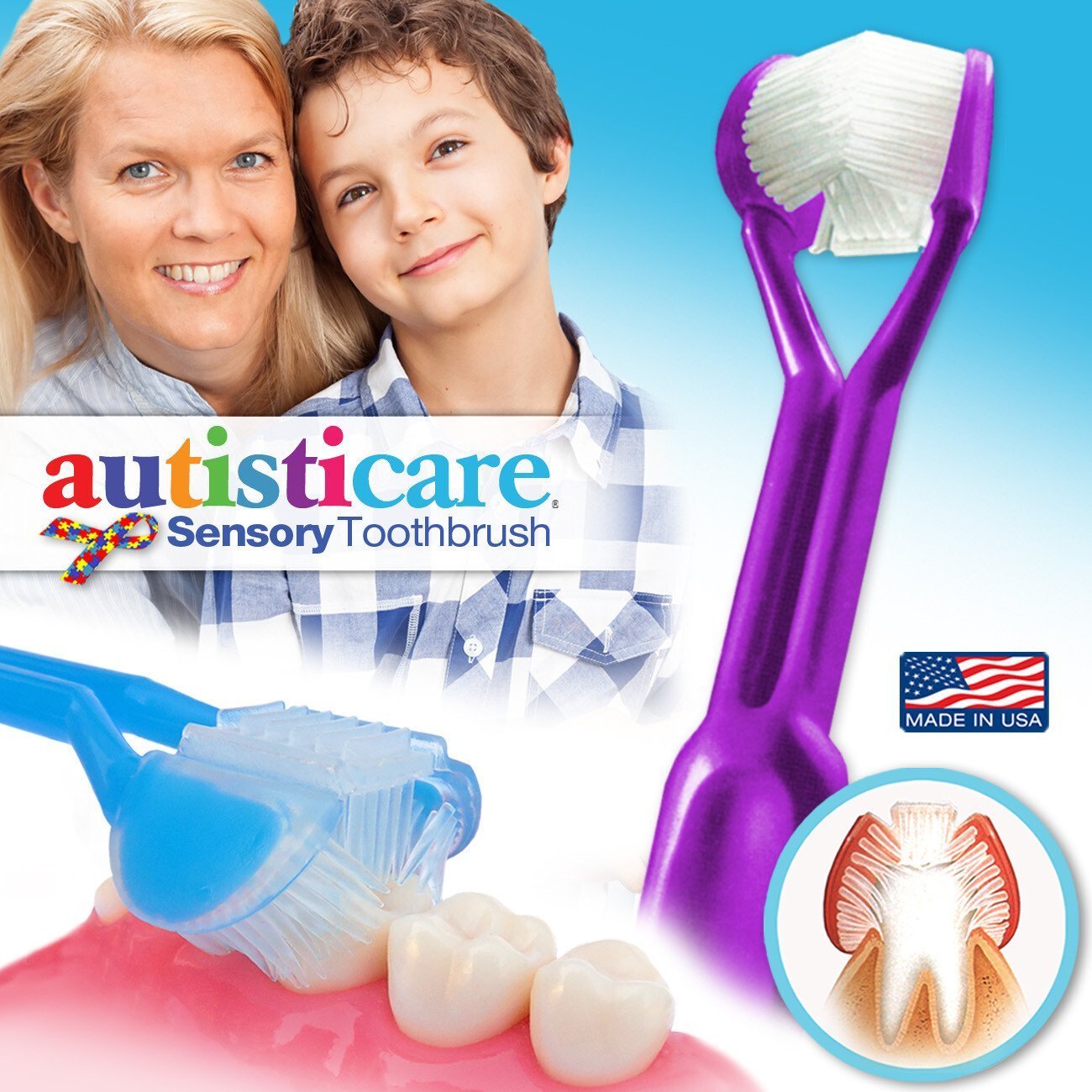- Toothbrushes for Special Needs Kids
Getting any child to brush their teeth can be a daunting experience. But getting a toddler with Autism to brush their teeth can be very challenging.
Over the years toothbrushes have evolved into more effective ways in which to better serve people of all abilities, especially people with a disability.
Which is why I’m listing the best toothbrushes for special needs kids. Also, be sure to check out these tips on what type of toothbrush works best for your child.
Triple Bristle Best Kids Sonic Toothbrush
This unique three-sided toothbrush was designed to help take the guesswork out of brushing. The soft angled bristles clean all sides of your teeth at once, helping you obtain a brighter, whiter smile in 1/3 the time. This toothbrush is great for children with Autism because of its innovative design.
Amazon – Check Here
3 Sided Autism Sensory Travel Toothbrush
With 360-degree coverage, this toothbrush comes in 3 different colors and has replaceable heads and a nonslip design easy for kids to grapple onto the toothbrush and brush their teeth. “Toothbrushes”
Amazon – Check Here
bA1 Health – 3-Sided Specialty Toothbrush
As a special needs parent, you probably don’t have a lot of this. We’re here to help. Wrap-around design + Auto 45-degree angle cleans the whole tooth (and gums) in 1 brushing stroke and gets where regular brushes can’t, and with less effort. It’s so effective it needs only 1 minute of brushing!
Amazon – Check Here
AutoBrush Pro Kids
This is a great toothbrush for children with Autism and many other disabilities. AutoBrush is the best toothbrush on the market to help people with disabilities brush independently, especially for kids who struggle with muscle weakness, lack of mobility, reduced motor function, sensory disorders, and cerebral palsy.
Brusheez Kids Electronic Toothbrush Set
This fun animal-themed electronic toothbrush is great for children with special needs especially Autism to help keep your child’s teeth super clean. It comes with.
- Two toothbrush heads
- 2-Minute sand timer
- Holder stand

Kohls – Check Here
Fatboy Toothbrush
Exactly as the name of this toothbrush says this toothbrush is made for children and teens with special needs to grip the toothbrush.
The PC-20Taper tip brush head has soft/medium tapered bristles for effective plaque biofilm removal around gums and teeth. Suitable for adults and children with disabilities and can be found here.

Kohls – Check Here
How do I get my Special Needs child to brush their teeth?
Maintaining good oral hygiene is essential for everyone, regardless of age or ability. However, for children with disabilities, the task of brushing their teeth can present unique challenges.
Whether it’s sensory sensitivities, motor coordination difficulties, or communication barriers, various factors can make toothbrushing a daunting experience.
Fortunately, with patience, creativity, and the right strategies, parents and caregivers can help their children develop healthy oral care habits. Here are some tips for making toothbrushing a positive and enjoyable experience for children with disabilities.
Establish a Routine:
Consistency is key when it comes to encouraging good oral hygiene habits in children with disabilities. Establishing a regular toothbrushing routine can help create a sense of predictability and familiarity, making the task less overwhelming. Choose a specific time each day – such as after breakfast and before bedtime – and stick to it. Incorporate toothbrushing into your child’s daily schedule to reinforce the importance of oral care as a non-negotiable part of their routine.
- Make it Fun
Turn toothbrushing into a fun and interactive activity by incorporating playful elements into the routine.
Use colorful toothbrushes, flavored toothpaste, and fun music to engage your child’s senses and make the experience more enjoyable.
Consider letting your child choose their toothbrush and toothpaste to give them a sense of autonomy and ownership over the process.
You can also turn toothbrushing into a game by pretending to be “toothbrush superheroes” or counting teeth as you brush.
Offer Choices:
Empower your child by offering them choices and allowing them to participate in the decision-making process.
Let them choose between different toothbrushes, toothpaste flavors, and even the location where they want to brush their teeth – whether it’s in the bathroom, at the kitchen sink, or in their bedroom.
By giving your child a sense of control and autonomy, you can help alleviate any anxiety or resistance they may have towards toothbrushing.
Use Visual Supports:
For children with communication or cognitive disabilities, visual supports can be incredibly helpful in guiding them through the toothbrushing process.
Create a visual schedule or step-by-step picture sequence that breaks down the task into manageable steps. Use pictures, drawings, or photographs to illustrate each step, from wetting the toothbrush to rinsing their mouth.
Visual supports can provide clarity and structure, helping your child understand what is expected of them during toothbrushing.
Celebrate Success:
Finally, don’t forget to celebrate your child’s achievements and progress along the way.
Praise their efforts, no matter how small, and offer plenty of positive reinforcement to motivate them to continue brushing their teeth independently.
Consider using a sticker chart or reward system to track their success and incentivize good oral hygiene habits.
By acknowledging their accomplishments and making toothbrushing a positive experience, you can help instill lifelong habits that will benefit their oral health for years to come.
Conclusion:
Encouraging a child with a disability to brush their teeth may require patience, creativity, and flexibility, but it is achievable with the right approach.
By establishing a consistent routine, using adaptive tools, making toothbrushing fun, offering choices, using visual supports, and celebrating success, parents, and caregivers can empower their children to develop healthy oral hygiene habits.
With time and perseverance, toothbrushing can become a positive and enjoyable part of your child’s daily routine, promoting good oral health and overall well-being.










Im grateful for the post. Really looking forward to read more. Really Cool.
bestwalletmall
https://www.bestwalletmall.com